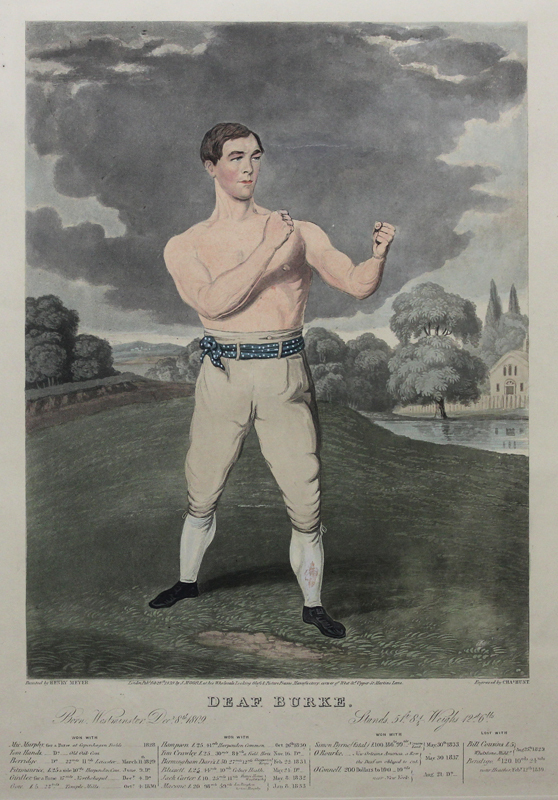
19th, 20th & 21st Century Fine Prints
707-546-7352 · fax 707-546-7924 · web: www.annexgalleries.com · email: artannex@aol.com
Deaf Burke (After a painting by Henry Meyer) by Charles Hunt

Deaf Burke (After a painting by Henry Meyer)
Charles Hunt
Title
Deaf Burke (After a painting by Henry Meyer)
Artist
Year
1839
Technique
hand colored aquatint
Image Size
15 3/8 x 11 3/4" image, 19-5/8 x 15-1/4" platemark
Signature
engraved in lower right, beneath image
Edition Size
not applicable
Annotations
engraved beneath image: "Pinted by Henry Meyer / London Pubd Feb 24th 1839 by J. Moore at his Wholesale Looking Glass & Picture Frame Manufactury, corner of West St, Upper St. Martins Lane / Engraved by Chas Hunt." Text in the lower margin gives B
Reference
Paper
thick antique-white wove
State
published
Publisher
J. Moore, London
Inventory ID
19595
Price
SOLD
Description
This color aquatint depicts James Burke, whose nickname, because of a hearing loss, was "Deaf". This was engraved by Charles Hunt after a painting by Henry Meyer and published by J. Moore in 1839. Charles Hunt was a British engraver of horse and sporting subjects active during the 19th century. He came from a family of engravers and was noted for his fine engravings after Pollard, Alken, Herring and other painters working in the genre. James "Deaf" Burke (8 December 1809 – 8 January 1845), 6 feet 2 inches (1.88 m) tall, 14 stone 4 pounds (91 kg; 200 lb), was one of England's earliest boxing champions. He trained in the area around the River Thames. On 30 May 30 1833, in a particularly brutal fight for the English heavyweight championship that lasted more than 3 hours, Burke defeated Simon Byrne, the Irish champion. Burke knocked him unconscious in the 10th round and Byrne died three days later. Burke was promptly arrested and tried for Byrne's murder, but he was acquitted on 11 July 1833 and subsequently freed. The former English champion Jem Ward, who had earlier retired rather than face Burke in the ring, refused to hand over the championship belt or acknowledge Burke as heavyweight champion. Following Byrne's death and the resulting stigma from having killed his opponent, Burke found it impossible to obtain opponents in Britain. One of Burke's major achievements was that he was the first British boxer to fight on American soil. It is also noted on the print that in 1837 he fought twice in the U.S., once against [the Irish champion, Sam] O'Rourke in "New Orleans America, a Row the Deaf-un obliged to cut." In other words, the fight degenerated into a brawl where the crowd surged into the ring and Burke fled on horseback fearing for his life. According to the print, almost three months later he won a bout with O'Connell "near New York" for a prize of 200 dollars. On 12 February 1839, Burke fought William Thompson for the English heavyweight crown. Burke was disqualified in the 10th round for hitting Thompson when he was down. Thompson retired the next month and Burke claimed the title. Jem Ward's younger brother Nick Ward fought Burke for the English championship on 22 September 1840. The fight ended in disarray when Ward's gang forced the referee to disqualify Burke for an alleged foul. Burke challenged William Perry, 'The Tipton Slasher', to a fight in July 1842. Perry declined. Burke won his final fight against Bob Castles (to whom he was related by marriage) in the 37th round on 13 June 1843. At age 35 and in extreme poverty, Burke died of tuberculosis at home on 8 January 1845 in Francis Street, Waterloo, London. He is buried in St John's Church-yard, Waterloo.
